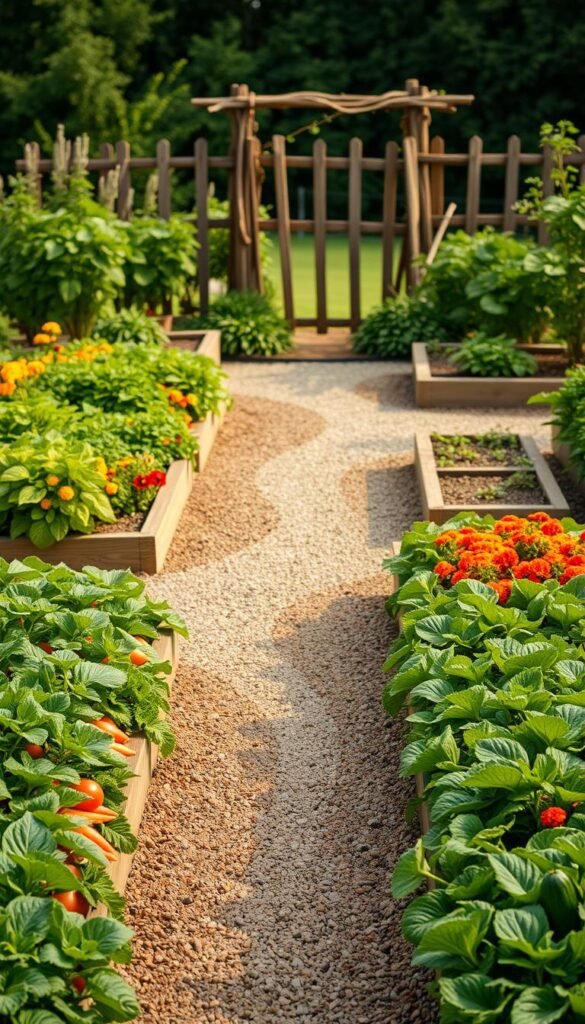Your outdoor area becomes a canvas when you approach it with thoughtful planning. Like fingerprints, no two growing spaces look alike – what works for your neighbor might not suit your sunlight patterns or favorite crops. This flexibility lets you craft a setup that balances productivity with visual harmony.
Many growers find success using methods like the square foot gardening method, which simplifies organization through grid-based planting. Whether you prefer neat geometric patterns or flowing natural shapes, your choices should reflect how you interact with the space daily.
Small urban balconies and sprawling backyards share one truth: smart design maximizes results. Strategic placement of plant groupings ensures easy access for watering and harvesting. Vertical structures like trellises add depth while saving ground area for root vegetables or leafy greens.
This guide explores how to align practical needs – like sunlight exposure and irrigation – with artistic touches that make your plot uniquely yours. You’ll discover how subtle adjustments to planting zones and walkways can enhance both function and curb appeal.
Understanding the Benefits of a Creative Garden Layout
A well-designed growing zone does more than just produce tomatoes and herbs – it becomes a living ecosystem. By blending practical space management with intentional design choices, you create environments where beauty and productivity thrive together.
Maximizing Space and Aesthetics
Smart arrangements turn limited areas into lush, functional displays. Vertical planters or tiered beds add layers for strawberries and flowers without crowding ground-level crops. Mixing edible plants with ornamental varieties creates eye-catching contrasts while attracting pollinators.
Consider how colors and textures interact. Purple basil beside golden marigolds isn’t just pretty – it confuses pests naturally. This approach reduces chemical use and supports local ecosystems.
Tailoring the Layout to Your Needs
Your unique situation dictates the best setup. Urban dwellers might use hanging baskets for herbs, while suburban growers could dedicate corners to berry bushes. Assess sunlight patterns and foot traffic before placing beds or pathways.
Time investment matters too. Low-maintenance perennials like rosemary work well for busy schedules. Those who enjoy daily tending might prefer succession planting in raised beds. Either way, your choices should simplify routines while boosting yields.
Planning Your Garden Space with Intention
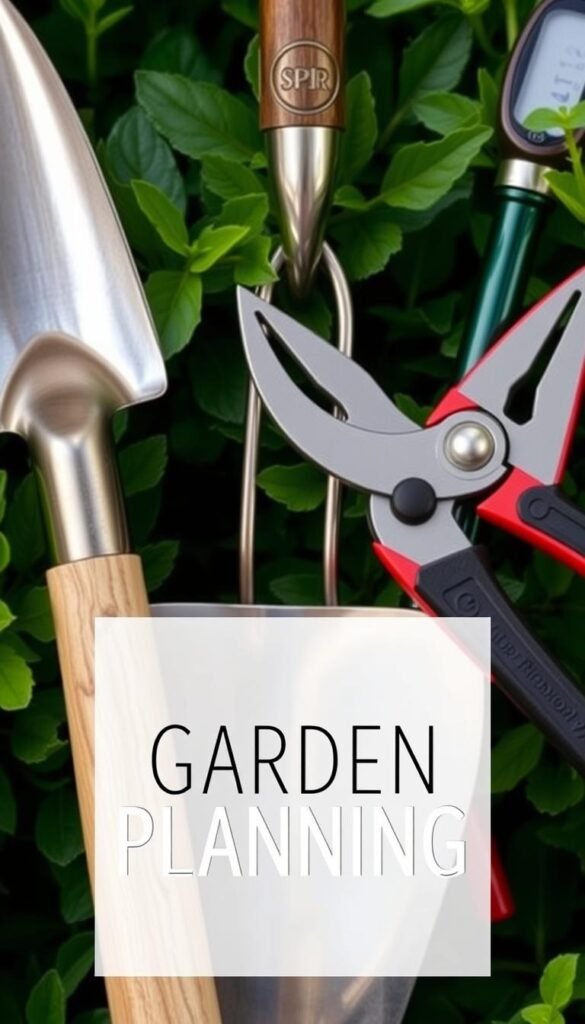
Transforming your plot starts with understanding its potential. Modern tools like garden planning apps help visualize possibilities while accounting for real-world limitations. These digital assistants let you experiment with different configurations before breaking ground.
Assessing Your Available Area
Begin by mapping sunlight patterns across your site. Track how shadows move throughout the day using free smartphone apps. Note where water pools after rain and areas near structures that might block airflow.
Test your soil’s pH and texture – kits from local nurseries make this easy. “Healthy dirt grows healthy plants,” as seasoned growers say. Pair these findings with your climate zone to identify suitable crops.
| Site Factor | Data to Collect | Planning Impact |
|---|---|---|
| Sun Exposure | Hours of direct light | Plant placement |
| Soil Quality | pH level, drainage | Amendment needs |
| Water Access | Spigot locations | Irrigation design |
Setting Priorities for Planting and Access
List your must-grow plants first, then balance with practical needs. Leave 18-24″ between beds for comfortable movement. Place frequently harvested herbs near pathways for quick snips while cooking.
Consider maintenance time when choosing layouts. Raised beds with built-in seating help gardeners with mobility challenges. Those short on time might prefer drought-resistant perennials over high-maintenance annuals.
Creative Garden Layout Ideas: Optimizing Rows, Beds, and Pathways
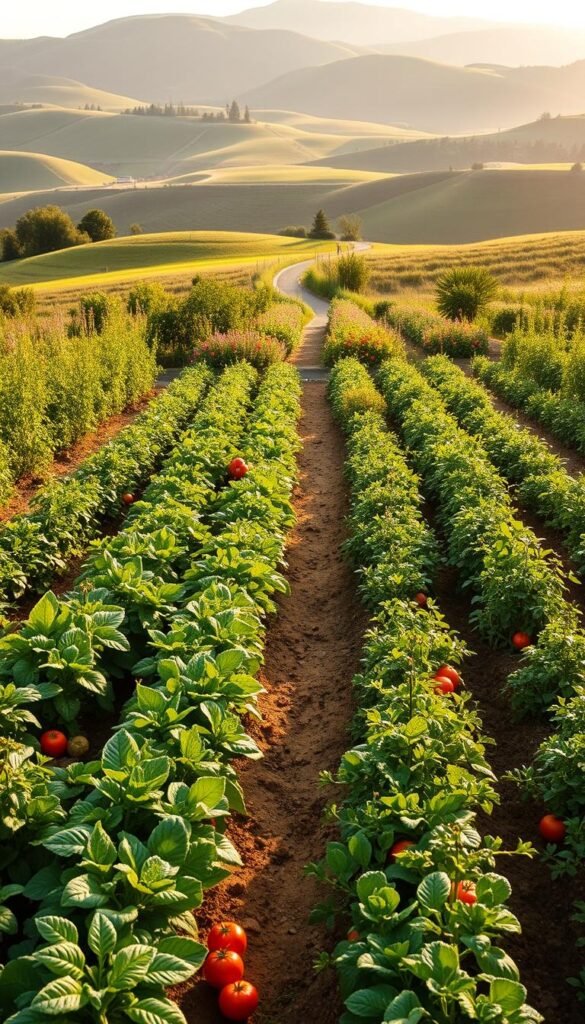
Efficient space management separates thriving plots from underperforming ones. While traditional rows work for large-scale farms, most home growers benefit from rethinking their approach. Let’s explore how block planting revolutionizes small-scale cultivation.
Comparing Rows vs. Block Planting
Row systems create walkways between plant lines – great for tractors but wasteful in backyard plots. Block planting groups crops tightly in geometric patterns, leaving minimal bare soil. This method boosts yields by 30-50% in the same area compared to single-row setups.
Leafy greens and root vegetables flourish in dense blocks. Garlic clusters naturally suppress weeds, while carrot patches create living mulch. For crops needing individual attention, rows still shine. Tomatoes demand staking space, and potato hills require soil mounding – single-line planting simplifies these tasks.
| Factor | Row Planting | Block Planting |
|---|---|---|
| Space Efficiency | 40-60% usable area | 85-95% usable area |
| Weed Control | Frequent cultivation needed | Natural canopy coverage |
| Best For | Vining plants, tall crops | Compact vegetables, herbs |
Pathways become crucial with block layouts. Keep them narrow (12-18″) but accessible. Curved walkways between rectangular beds add visual interest while maintaining functionality. Learn more about strategic spacing techniques to enhance your growing space.
Maximizing Vertical Gardening Potential
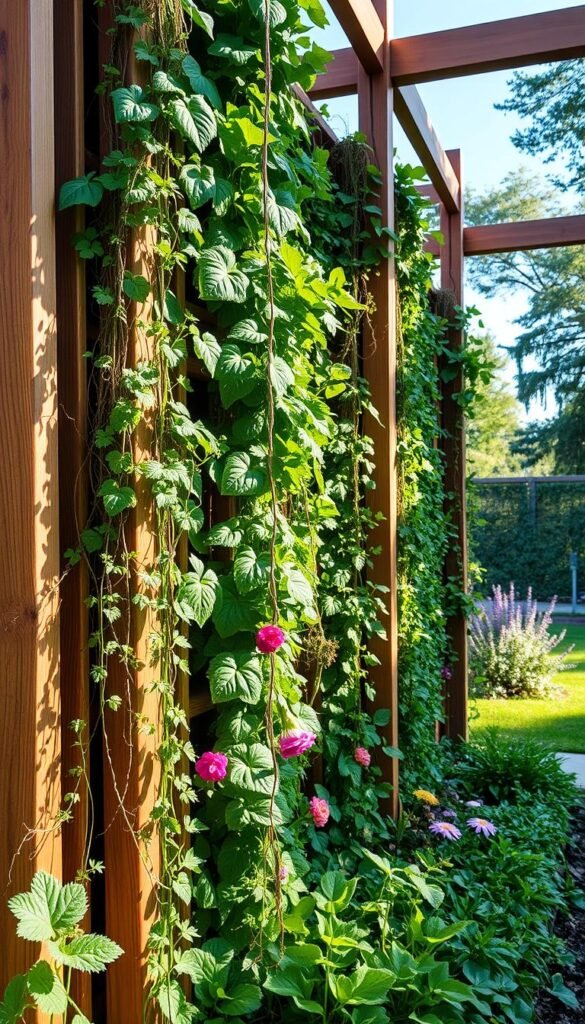
Looking up could be your secret weapon for doubling harvests without expanding ground plots. Vertical systems let you grow plants upward, creating layered growing space that works smarter – not harder. This approach turns blank walls and empty air into productive zones for vining crops and shade-loving greens.
Utilizing Wall and Trellis Supports
Start simple with bamboo stakes for peas or repurpose old ladders as cucumber frames. Sturdy metal grids handle heavy squashes, while lightweight netting suits delicate beans. “The right support becomes part of your garden’s architecture,” notes urban farmer Lisa Chen. Match structures to your plants’ mature weight and spread.
| Support Type | Best For | Installation Tips |
|---|---|---|
| A-Frames | Cucumbers, melons | Anchor legs in soil |
| Wall Grids | Malabar spinach | Use rust-proof fasteners |
| Obelisks | Flowering vines | Place in containers |
Selecting the Best Climbing Plants for Your Space
Pole beans and achocha climb eagerly, while squash needs encouragement. Train tendrils early using soft ties. Underneath these vertical growers, plant lettuce or spinach that thrives in dappled shade. This stacking method maximizes height while protecting tender greens from harsh sun.
Consider growth speed – fast-growing peas make quick screens, while perennial grapes require permanent structures. Mix edible and ornamental climbers like scarlet runner beans for dual-purpose beauty. Your vertical space becomes a living curtain of productivity.
Exploring Companion Planting and Mixed Crops
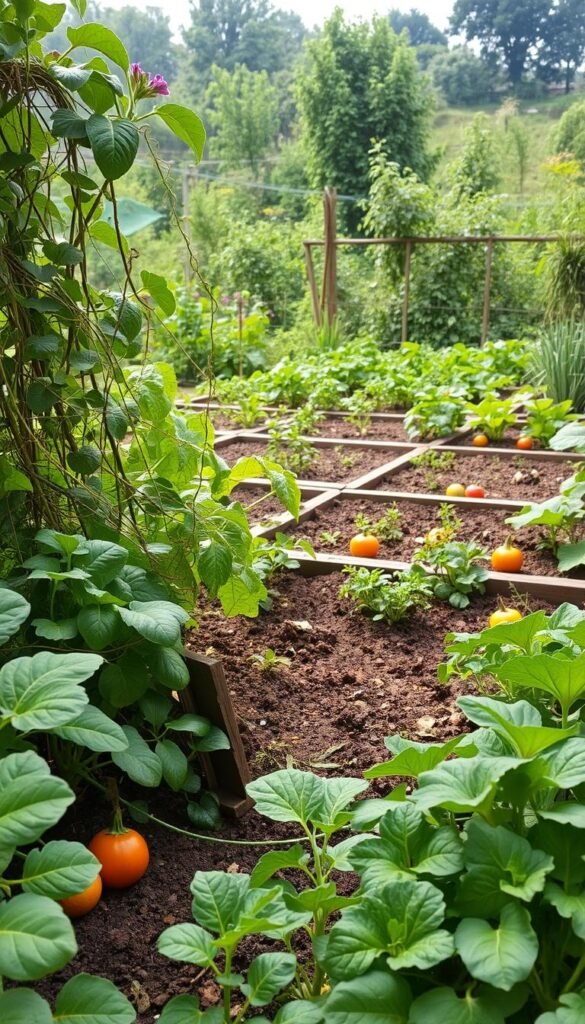
Smart growers know plants thrive better together than alone. Pairing compatible species creates a natural support system, boosting yields while reducing maintenance. This method works like a botanical buddy system, where each plant contributes unique strengths.
Interplanting for Mutual Benefits
The radish-carrot duo shows how timing creates harmony. Scatter both seeds in the same bed – radishes sprout fast, marking rows while loosening soil. By harvest time, carrot seedlings claim the space as their slower growth phase begins.
| Primary Crop | Companion | Key Benefit |
|---|---|---|
| Carrots | Radishes | Soil aeration & space sharing |
| Tomatoes | Basil | Pest deterrence |
| Corn | Beans | Natural nitrogen fixation |
Science-backed pairings go beyond tradition. Marigolds release root chemicals that repel nematodes, protecting nearby tomatoes. Tall cornstalks shield lettuce from harsh sun in summer months.
For year-round strategies, explore companion planting for stronger plants through seasonal changes. These partnerships minimize empty spaces while creating pest-resistant ecosystems. Your crops become mutual allies, not competitors.
Optimizing Garden Beds and Raised Bed Solutions
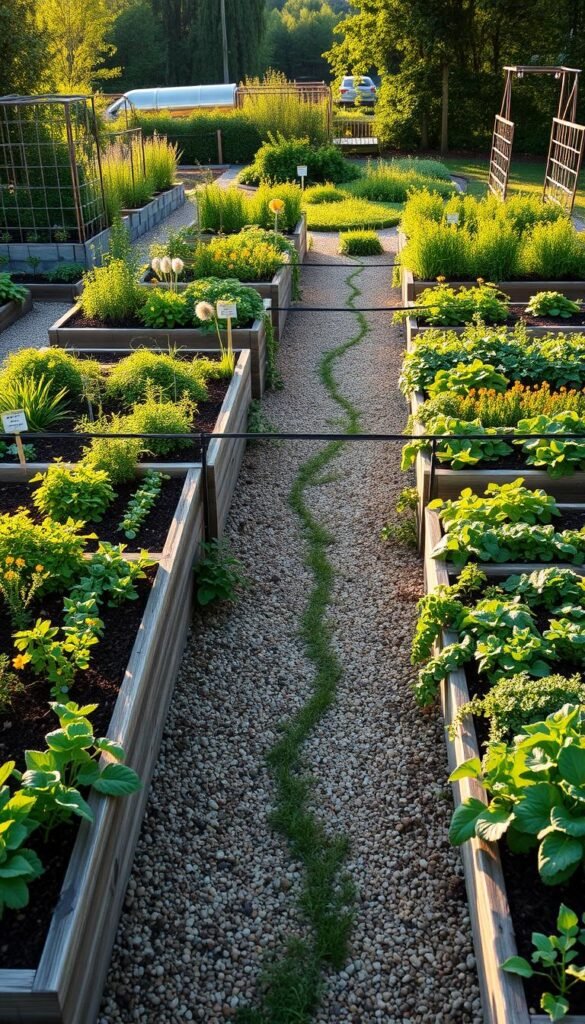
Struggling with rocky ground or constant puddles? Raised beds turn problem spots into productive growing zones. These elevated systems let you bypass poor native soil while improving drainage and accessibility – perfect for urban patios or sloped yards.
Benefits of Raised Beds
You control the soil quality from day one. Fill frames with nutrient-rich compost and organic matter instead of fighting clay or sand. This creates ideal conditions for roots to thrive. “My arthritis doesn’t stop me now – I can tend plants without bending,” shares home gardener Marcia Tobin.
| Bed Height | Best For | Material Options |
|---|---|---|
| 6-12″ | Root vegetables | Cedar, recycled plastic |
| 18-24″ | Accessible gardening | Galvanized steel |
| 30-36″ | Wheelchair users | Concrete blocks |
Designing Beds for Better Access and Harvest
Keep widths under 4 feet so you can reach the center without stepping on soil. Pair narrow garden beds with 2-foot pathways for easy movement. Follow our step-by-step raised bed guide to create custom sizes that fit your space.
Rotate crops effortlessly each season – simply refresh the topsoil layer. Taller structures protect plants from pests and make harvesting strawberries or herbs a back-friendly task. Your growing area stays organized and adaptable year after year.
Container Gardening for Small Spaces
Urban balconies and fire escapes prove you don’t need acreage to cultivate fresh produce. With strategic container choices, you can grow vegetables like cherry tomatoes and rainbow chard in tight quarters. The key lies in matching plant needs to vessel size and soil quality.
Beyond Basic Pots
Old colanders become strawberry planters when lined with coconut coir. Wine barrels sliced in half offer depth for carrots and potatoes. Just drill drainage holes and fill with nutrient-rich potting mix. “Containers let you turn forgotten corners into food sources,” notes urban gardener Diego Martinez.
| Container Type | Best Vegetables | Size Requirements |
|---|---|---|
| Grow Bags | Peppers, Eggplants | 5-7 gallons |
| Window Boxes | Lettuce, Radishes | 6″ depth minimum |
| Storage Totes | Zucchini, Cucumbers | 10+ gallons |
Fabric grow bags outperform rigid pots in root health – their breathable walls prevent overheating. Pair these with dwarf varieties like ‘Patio Princess’ tomatoes that thrive in confined spaces. For visual flair, mix edible greens with flowers that brighten your growing area while attracting pollinators.
Watering becomes crucial in containers. Use self-watering pots or add mulch to retain moisture during heatwaves. Rotate planters weekly so all sides get equal sun exposure. Your compact setup will rival traditional plots in productivity.
Implementing Square Foot and Efficient Planting Techniques
Imagine transforming your growing area into a precise grid where every inch works harder for you. The square foot method turns traditional planting on its head, using geometric efficiency to boost harvests. This approach works equally well in raised beds or ground plots, letting you grow up to five times more food than conventional rows.
Planning with a Grid System
Start by dividing your space into 12×12-inch squares using string, wood strips, or permanent markers. Each section becomes a mini-plot for specific vegetables based on their mature size. Follow this simple formula: large plants (tomatoes) get 1-2 squares, medium ones (bush beans) need four per square, and small varieties (radishes) pack 16.
| Plant Type | Per Square | Spacing Guide |
|---|---|---|
| Leafy Greens | 9 | 4″ apart |
| Carrots | 16 | 3″ rows |
| Peppers | 1 | 12″ circle |
Combining Crops for Optimal Yield
Mix quick-growers with slow starters in shared squares. Sow spinach and radishes together – harvest the radishes just as spinach needs more room. Pair vertical growers like peas with shade-tolerant lettuce below. This stacking technique maximizes yield while keeping soil covered.
For best results, follow our perfect square foot gardening layout guide. Rotate crops seasonally using the grid as your map – replace spring peas with fall kale in the same squares. Your systematic approach reduces weeding and simplifies care.
Designing Pathways for Accessibility & Efficiency
Your pathway plan makes all the difference between a cramped plot and a bountiful harvest zone. Strategic design choices let you reclaim valuable growing real estate while keeping every plant within reach. The goal? Create clear routes that serve your needs without gobbling up precious square footage.
Minimizing Space Lost to Walkways
Dead-end paths offer smart solutions for large beds. These partial walkways allow you to tend crops without cutting through entire planting zones. Imagine reaching spinach clusters at the front while leaving deeper sections undisturbed – you maintain access while preserving growing space.
Keyhole patterns take this further. Curved indentations in rectangular beds create multiple entry points from single pathways. You’ll rotate comfortably around central areas, reducing the need for parallel walkways. Studies show these designs can dedicate less than 15% of total area to foot traffic.
Stepping stones provide dual functionality. Place flat rocks at strategic intervals between low-growing herbs or flowers. You’ll have stable footing for maintenance while plants flourish around the edges. This approach works particularly well in small urban gardens where every inch counts.

